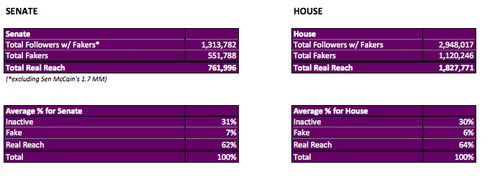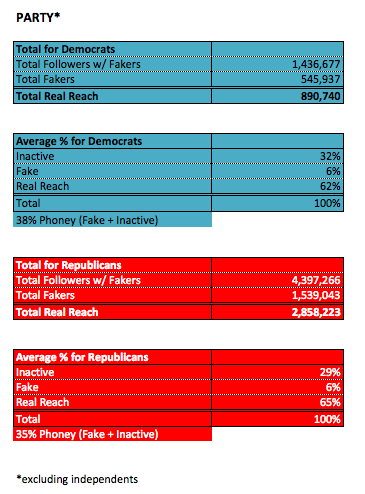22
Aug
Congressional Twitter Accounts Are Plagued by Phony Followers
by jon tilton
Covered by The Hill, National Journal, Washington Times, The Blaze, etc…..
The Huffington Post piece from last week regarding the high number of fake Twitter followers Obama has, over 60%, piqued Advocacy Media’s interest.
The latest buzz concerning influencers, athletes, Hollywood elites, politicians etc., paying to boost their Twitter follower count – Ashton Kutcher being one, has built his online empire via Twitter. According to StatusPeople, roughly 26% of his 11.9 MM followers are “fake” and another 45% are inactive. Interesting. So, he is really reaching only 29% or 3.5 MM of 12 MM followers. HMMMM. And that’s when they’re actually on Twitter (remember: the shelf-life of a tweet is one hour; just sayin). How effective is Empire Ashton, really? Do you think this revelation will shape future contract negotiations since he’s played the strong social graph card so well? And for the Kardashian clan? Oy, we digress…
Using the same tool to determine any Twitter handle’s “faker score” led us to check out the congressional elites scores, and well, all is still not good with Congress and communications via social media channels, or any electronic medium for that matter.
Curious, we began plugging away, first checking out all the Senate candidates, to which we realized that the real question is how many of the current elected officials (House AND Senate) are broadcasting to a “ghost” audience. And, could we pick up on any noticeable ratios or data points that would presumably point to an official that is paying for their followers. Fully immersed in the quest, we built a file of ALL elected representatives with each official’s respective “faker” score. Essentially, we pulled together detailed information, data amounts, concerning the number of fake, and inactive, Twitter accounts following Congress, and Senate candidates.
The few that are a little suspect include:

Official Congressional Twitter Handles: Note: the numbers reflect StatusPeople’s updated methodology. We’ve included all of our before and after results; approximately a -4% change overall.
The average Representative Twitter account has 3k – 6k followers, with roughly 6% “fake” followers and 30 % “inactive”. According to Advocacy Media’s findings, all congressional twitter accounts are plagued by fake followers; in fact, 36% of all Twitter accounts following congressional offices are phony accounts.
Furthermore, we’ve determined the big question is, considering how pervasive faker-bots, spam-bots, are on Twitter, how effective is Twitter as a tool to resonate messages to constituents? Congress reluctantly began to use Twitter due to its ubiquity and because it represented a new medium to connect with constituents. Remember, Representative Culberson’s affinity for the tweeter, then the apparent 180 because according to Rep Culberson, “he had had it with all the noise.” Now that the curtain has been pulled back, it’s likely communications to and through Twitter to Congress are really not that effective after all. And, if you’re broadcasting to a supposed group of advocates, you should check your score.
Congressional staffers base the relevancy and importance of someone’s communications via Twitter by their influence — the number of followers they have, for the most part. The findings show that anyone can grow a fake following, point their message to a congressional handle and be noticed.
As for the congressional handles, there obviously are a few that have seeded their account, but we believe that is beside the point. Twitter is run amuck with spam and phony accounts. It’s mostly noise.
Based on our experience managing digital issue and brand marketing campaigns, the findings really do make us rethink the legitimacy of utilizing Twitter as a communications tool, and how to build an organic, socially active community of issue and brand advocates to resonate messages on behalf of our clients.
As for the debate over engagement vs. follower count as proof of social media success, the value of a platform like Twitter is not so much about reach as it is engagement. There are more efficient methods for reach than Twitter, like display ads or online media ads. Yes, retweets do drive traffic, but a majority of the click-throughs are in the first five minutes of being “tweeted” out. If you have a ton of phony followers, how is that effective? It’s just wasted campaign resources and totally misses the point of why a campaign, or individual, should be using Twitter in the first place.
You should want to earn a follower base of real people that actually care about engaging and sharing - last we checked, phony bots don’t do that. Yet.
Since Gingrich was exposed last year for having a high phony follower base, it definitely makes more sense for Congressional offices and campaigns to scrub their followers. In this new age of transparency in social media, the risks outweigh reward.
Furthermore, we believe the high follower-win correlation for political candidates has finally been debunked!
Twitter has a really big problem and it’s not going to be easy ridding itself of phony accounts.


Methodology
As for accuracy, StatusPeople and their methodology, they apply statistical analysis, take a random sampling of 1,000 followers for up to 100,000 of any given handles’ total universe of followers. Based on our experience, random sampling is pretty accurate. StatusPeople was used by Huffington Post for the Obama piece and TheNextWeb article here. They’ve recently updated their methodology here.
 jonmtilton posted this
jonmtilton posted this